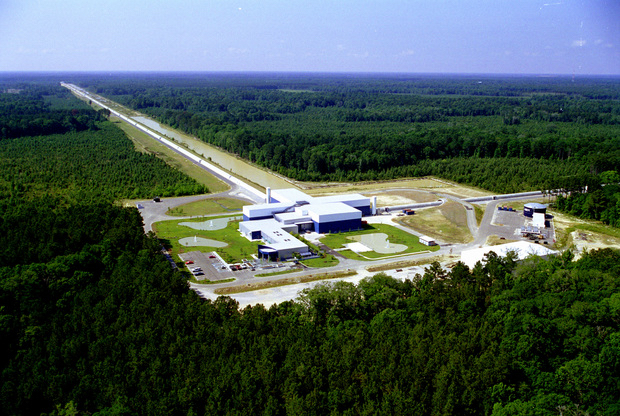About Gravitational Waves
What are gravitational waves?
Astronomers learn about the Universe by measuring signals that have travelled to Earth from distant stars and galaxies. The first observations were of visible light, which arrives as electromagnetic waves. Later, astronomers learned to sense other electromagnetic wavelengths, including radio signals, x-rays, and gamma-rays. Modern astronomers also measure the impact of particles like neutrinos and cosmic rays.
Gravitational waves are a new window on the Universe. Called the ''sounds of the universe'' or ''ripples in spacetime'', they are waves in the fabric of space and time itself, rippling out from accelerated masses, and shifting the distances between objects as they travel. These shifts are very weak. The strongest signals we might measure on Earth are from orbiting pairs of black holes or neutron stars - very compact objects, more massive than the sun, zipping around each other tens to hundreds of times each second.
Gravitational waves were directly detected on September 14, 2015 and December 26, 2015 by the Laser Interferometer Gravitational-wave Observatory. The source of these waves was a binary black hole system located 1.3 billion light years from earth. With this discovery, many researchers have joined together to realize the potential of LIGO, finding out about a side of the Universe that was hidden from us before. GWPAC Director Joshua Smith expands upon this in an interview with Tomorrow's Daily.
LIGO: The Laser Interferometer Gravitational-wave Observatory

LIGO Livingston Observatory (Credit: LIGO)
In the U.S. there are currently gravitational-wave detector sites in Hanford, Washington and Livingston, Louisiana. These observatories bounce laser beams off mirrors to measure minuscule changes in the distance along their two perpendicular arms. Each arm is about two and a half miles long, and the Initial LIGO was sensitive to changes in their length smaller than the size of a proton. The new Advanced LIGO gravitational-wave detectors are ten times more sensitive than Initial LIGO. With continued improvements, we expect dozens of detections in the next few years.
Read more about LIGO sensitivity in LIGO scientist Amber Stuver's blog post, "Why isn't LIGO sensitive to GW from the Sun, Moon, or Planets?".
More Information
The LIGO Scientific Collaboration's Science overview (en Español).
Short and easy to understand introductions to a number of topics related to gravitational waves and the instruments used to detect them: GW Optics e-book (in English, Español, 简体中文, Deutsch and Italiano).
Read an article about LIGO and gravtitational waves with Dr. Jocelyn Read (en Español![]() ).
).
A game where you listen for gravitational wave signals: Black Hole Hunter.
Gravitational wave introductory articles at LIGO's What are Gravitational Waves? and Gravitational Waves at Einstein Online.
